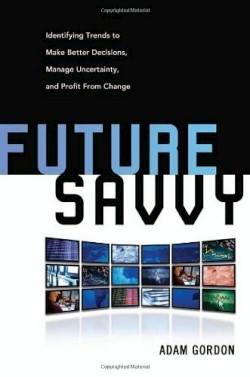Future Savvy
Identifying Trends to Make Better Decisions, Manage Uncertainty, and Profit from Change
Business executives are undoubtedly familiar with forecasting, but forecasts are, in essence, educated guesses of what could occur at some point down the road. As Adam Gordon points out in Future Savvy, predicting the future is a very tricky game.
Gordon wrote this book because, he says, so few resources are available about evaluating forecasts. He hopes to bring some amount of “quality control” to the field. His goal is to show decision makers “how to evaluate forecasts and extract value from them,” and he does so by offering a thorough examination of various key aspects of forecasting, from data quality to “bias traps” to the limitations of quantitative forecasting.
While the author steps through these and other attributes of forecasting in a fair amount of detail, the book culminates in a fascinating chapter that puts theory into practice. In Chapter 10, Gordon reproduces numerous forecasts that are publicly available and analyzes them with an eye towards whether each leads to “good or bad future thinking.”
One particularly relevant forecasting example is “America’s Home Forecast” for 2004—2013, created by the Homeownership Alliance. The study includes the outlook for housing demand and supply, the outlook for home prices, and the future of mortgage market demand and supply. The forecast was created in 2004 and was decidedly upbeat. It projects home price appreciation that averages about five percent annually. The study says “the likelihood of a decline in home prices at the national level is quite remote.”
Of course, we now know the opposite is true. The housing bubble burst in 2008; homeowners were caught in a sub-prime mortgage crisis, and falling prices resulted in massive foreclosures. Gordon asserts: “The forecasts made are wrong. A key assumption on which the forecast was based—continued availability of cheap mortgages—changed, changing the future entirely.” This study alone drives home Gordon’s thesis.
As the author says, “Forecasts are an indispensable but highly patchy guide to the world of tomorrow. We take them seriously because understanding future conditions and requirements is key to future success, but we need to assert strong independence of mind as to whether any forecast is valid.” Adam Gordon concludes the book with a helpful checklist of sorts that considers such factors as specificity, information quality, and assumptions. With this checklist in hand, a business manager should be in a much better position to evaluate the validity of a forecast.
Reviewed by
Barry Silverstein
Disclosure: This article is not an endorsement, but a review. The publisher of this book provided free copies of the book to have their book reviewed by a professional reviewer. No fee was paid by the publisher for this review. Foreword Reviews only recommends books that we love. Foreword Magazine, Inc. is disclosing this in accordance with the Federal Trade Commission’s 16 CFR, Part 255.

